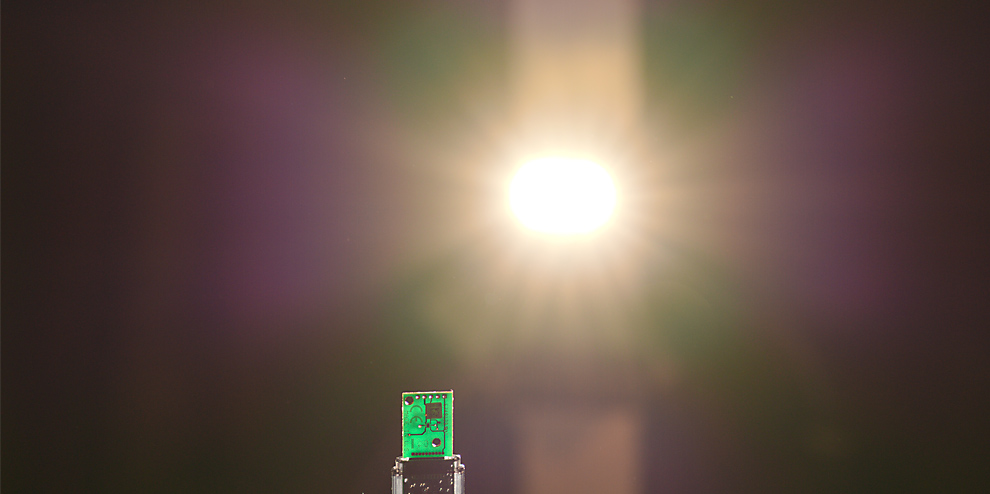LIGHT FLOW
Lumens are the unit of luminous flux and it is the amount of light that a given light (headlamp) produces.
Lumens are a useful unit of measurement between different lights - a light with more lumens is more powerful, it shines more. Lumens indicate the total amount of light, but do not tell how narrow or wide the beam is concentrated. Lights that shine in a point-like manner then appear to us to be more powerful than those that are more diffused into space even though they may have fewer lumens (lower overall luminous flux).
The lumens of light can be tentatively calculated from the data sheet of the LED chips, the passing current, the heating losses and the losses on the optics. Lumens can be accurately measured in an integrating sphere, which are expensive laboratory devices. We use our own integration sphere to verify the lumen output of our headlamps, using a measured reference sample as a standard.

The lumen count of our headlamps
| Headlamp model | Max. lumens |
|---|---|
| Lucifer Z2Mini/Z2Micro | 850lm |
| Lucifer S2RED | 800lm |
| Lucifer S2X | 1200lm |
| Lucifer M6 | 1700lm |
| Lucifer L+ | 3200lm |
| Lucifer X | 5000lm |
| Lucifer ULTRA | 8000lm |
How many lumens are enough for what?
- Camping: 5-10 lm
- walking: 10-25 lm
- recreational trail running: 50-100 lm
- fast running off-road: 200-400 lm
- orienteering (night training): 400-800 lm
- orienteering (night race): 800-1600 lm
- night mtb ride: 400-800 lm
- night mtb race: 800-1600 lm
- mushing-victory race: 800-3200 lm

LIGHT INTENSITY - LUX
Lux is a unit of illuminance and determines the illuminance at one specific point measured - that is, how much light falls on one specific point. Lux can be easily measured with a lux meter, this is used e.g. to measure the sufficient level of illumination of work areas, desks in offices etc.
Spot lights have higher lux values than diffuse lights. So it does not automatically mean that a light with higher lux illuminates more (has a higher luminous flux)!
1 lux is defined as the illuminance of an area of 1m2 illuminated by 1 lumen.
Lux (illuminance) decreases quadratically with increasing distance. So, for example, if a light has an intensity of 10000 lux at 1 m, it will have an intensity of 2500 lux at 2 m, only 400 lux at 5 m (=10000/(5*5)) and only 100 lux at 10 m (=10000/(10*10)). At 100 m it will be only 1 lux.
Some common values of light intensities:
- 1 lux - moonlight
- 10 lux - a candle at a distance of 30cm
- 400 lux - normal office
- 50000 lux - sunny day
Illumination intensity at 1m for our headlamps:
| Headlamp model | Number of lux at 1m from the headlamp |
|---|---|
| Lucifer Z1, 20° | 3850 lux |
| Lucifer S2X, 13°+20° | 6200 lux |
| Lucifer M6, 13°+29° | 8200 lux |
| Lucifer L, 13°+13°+13°+29° | 19900 lux |
| Lucifer X, 6x13° | 38000 lux |
| Lucifer ULTRA, 9x13° | 55000 lux |
DOSVIT
The range is given as the distance at which the illuminance of the flashlight drops to 0.25 lux. However, this is approximately the illumination intensity produced by the full moon under clear skies, so the intesity is quite low. The usable range is of course lower. The value, according to ANSI/NEMA FL 1-2009, is read between 30 and 120 seconds after the flashlight is turned on. In the case of lights without a constant regulation, the range logically decreases during discharge.
The ranges of our headlamps:
| Headlamp model | Range |
|---|---|
| Lucifer Z1, 20° | 125m |
| Lucifer S2X, 13°+20° | 159m |
| Lucifer M6, 13°+29° | 182m |
| Lucifer L+, 13°+13°+13°+29° | 285m |
| Lucifer X, 6x13° | 390m |
| Lucifer ULTRA, 9x13° | 480m |